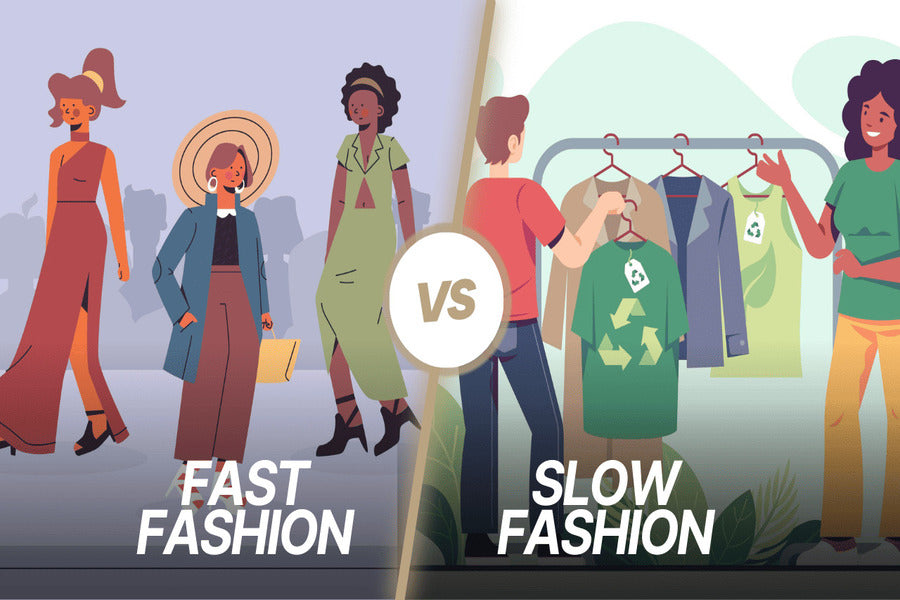
Fast Fashion vs Sustainable Fashion: Understanding the Key Differences
Key Takeaways
- Curious about the true cost of fashion? Discover how fast fashion’s quick production cycles harm the environment and what sustainable fashion does differently.
- Wondering how to spot a fast fashion brand? Learn the telltale signs, from super-low prices to low-quality materials, that separate fast fashion from ethical brands.
- Is sustainable fashion worth the higher price? Uncover the long-term benefits of investing in durable, eco-friendly clothing compared to the short-lived trends of fast fashion.
- Fast fashion vs sustainable fashion: which is better for you? Understand the core differences between these two approaches and how your fashion choices can impact the planet.
What Is Fast Fashion?
Fast fashion refers to the practice of mass-producing affordable clothing that mirrors runway trends. Major retailers like Zara, H&M, and Shein create trendy pieces at low costs, allowing consumers to wear the latest styles without breaking the bank. However, the emphasis on speed and volume often comes at the expense of quality and sustainability, as these brands focus on getting new items on shelves quickly.

Amidst an abundance of abandoned goods, women look for wearable clothing
Amidst the growing issue of abandoned, unworn clothing, fast fashion thrives by encouraging consumers to buy new clothes constantly. Retailers achieve this through frequent collection turnover, enticing shoppers with new styles every week or month. This constant cycle of consumption has severe consequences, contributing to environmental degradation and waste while promoting unsustainable fashion habits.

How To Spot A Fast Fashion Brand?
Fast fashion brands are easy to identify once you know the signs. They frequently release new collections—sometimes as often as weekly—so you’ll always find something new on their racks. Their products are usually made with cheap, harmful materials like polyester, and prices are so low that they seem too good to be true, raising red flags about the quality and ethics behind their production.
Another hallmark of fast fashion brands is their lack of transparency when it comes to their supply chain and sourcing practices. These companies tend to offer little information about where their materials come from or how their clothing is made. If a brand is vague about its production process and offers suspiciously low prices, it’s likely part of the fast fashion industry.
Pros & Cons Of Fast Fashion
Fast fashion has clear benefits, but they come with significant downsides. One of the biggest advantages is affordability—customers can purchase the latest trends at a fraction of the price of high-end brands. Fast fashion brands also keep up with evolving styles, so shoppers always have access to the newest designs.
However, these benefits are offset by fast fashion’s impact on the environment and society. The industry’s reliance on mass production leads to excessive carbon emissions and significant water use, damaging ecosystems. Additionally, many fast fashion companies outsource production to countries with poor labor conditions, where workers face low wages and unsafe environments. Moreover, the low-quality materials used mean that these clothes often wear out quickly, leading to more waste.

Fast fashion is accessible, yet it has a lot of negative aspects.
|
Pros |
Cons |
|
|
What Is Sustainable Fashion?
Sustainable fashion aims to minimize environmental harm while improving social well-being. It focuses on using eco-friendly materials and ethical production methods, which often come with a higher price tag. Brands like Patagonia, Stella McCartney, and Everlane advocate for this movement, creating durable, high-quality clothing that respects both people and the planet.
At its core, sustainable fashion seeks to reduce waste by slowing down the production cycle and promoting more thoughtful consumption. Instead of quickly cycling through trends, sustainable brands focus on creating long-lasting garments that prioritize quality over quantity. This shift encourages consumers to invest in pieces that endure, rather than indulging in short-lived trends.

Customers are tempted to choose between style, quality, and values when it comes to fashion
When it comes to fashion, consumers are often forced to choose between style, quality, and their values. Sustainable fashion makes it easier to balance these priorities by offering stylish yet ethically made clothing. However, the higher cost of sustainable options can make this choice challenging for budget-conscious shoppers.
How To Spot A Sustainable Fashion Brand?
Recognizing a sustainable fashion brand becomes easy when you know the key features to look for. These brands often use eco-friendly materials such as recycled fabrics, organic cotton, and biodegradable fibers. Their products are made with the environment in mind, aiming to reduce carbon emissions, conserve water, and minimize waste throughout the production process.

Emphasizing essential components like biodegradable packaging, plant-based dyes, and renewable textiles
Transparency is another crucial element. Sustainable fashion brands are usually open about where their clothes are made, who makes them, and under what conditions. Look for brands that adhere to fair trade practices, ensuring workers are paid fairly and provided with safe working environments.
Sustainable fashion brands also tend to release fewer collections, focusing on timeless, classic styles that outlast fleeting trends. Their approach emphasizes quality over quantity, which not only reduces waste but also encourages consumers to buy less and choose better. By looking for these signs, you can make more informed decisions and support companies that prioritize sustainability.
Pros & Cons Of Sustainable Fashion
Sustainable fashion offers many benefits, but it also presents some challenges. One major advantage is its positive impact on the environment. By using eco-friendly materials, these brands reduce carbon emissions, conserve water, and generate less waste, making their clothes much kinder to the planet compared to fast fashion.

Another benefit is the improvement in working conditions. Many sustainable fashion brands ensure ethical labor practices, meaning that workers are treated fairly and paid living wages. The durability of sustainable clothing is another plus—garments made with high-quality materials tend to last longer, providing better value over time.
However, sustainable fashion is often more expensive than fast fashion due to the ethical sourcing of materials and fair labor practices. This higher cost can be a barrier for many shoppers. Additionally, the smaller number of collections and focus on timeless designs can be less appealing to trend-driven consumers who prefer frequent wardrobe updates.
|
Pros |
Cons |
|
|
Fast Fashion vs Sustainable Fashion: The Core Differences
The key difference between fast fashion and sustainable fashion lies in their approach to production and consumption. Fast fashion prioritizes quick turnaround times and low prices, encouraging a culture of overconsumption and disposability. Sustainable fashion, on the other hand, focuses on quality, longevity, and ethical practices, aiming to reduce the negative impact on the planet.
While fast fashion offers immediate access to trendy clothing at a lower price point, it comes with significant environmental and social costs. Sustainable fashion may have a higher upfront price tag, but it offers better value in the long run, as it promotes responsible sourcing and labor practices. The debate between fast fashion vs sustainable fashion ultimately comes down to a choice between convenience and conscience.
The Future of Fashion: Sustainable vs Fast Fashion

As awareness of fast fashion’s detrimental effects grows, the demand for sustainable fashion is increasing. Consumers are starting to realize that they have the power to drive change through their purchasing choices. By supporting sustainable fashion brands, people can help push the industry toward more responsible and eco-friendly practices.
The fashion industry is slowly responding to these demands, with more brands adopting sustainable methods and offering eco-friendly alternatives. However, the transition from fast fashion to sustainable fashion will take time, and it requires both brands and consumers to make conscious decisions. With a collective effort, the future of fashion can be more ethical, sustainable, and mindful of its impact on the world.
FAQs
Why is fast fashion not sustainable?
Fast fashion cannot be sustained since it is based on mass production, which results in waste, pollution, and unethical labor practices. Quantity over quality leads to the production of disposable apparel, which increases landfill trash.
What is considered sustainable fashion?
Sustainable fashion is defined as apparel made using environmentally friendly materials and production methods that put worker and environmental welfare first. It has longevity, less waste, and ethical sourcing.
What is the difference between sustainable and ethical fashion?
Whereas sustainable fashion is more concerned with the environment, ethical fashion is concentrated on social responsibility, such as giving workers a fair wage and offering safe working environments. Their primary goals differ, despite the fact that they usually coincide.



